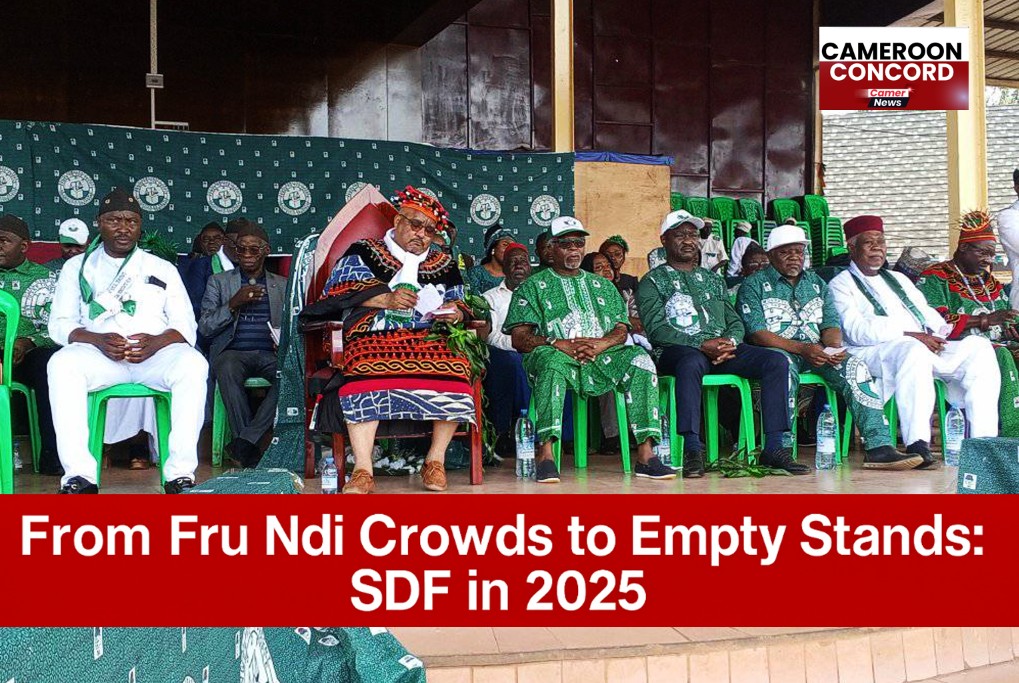- Details
- Politics
SDF in 2025: From Fru Ndi’s Crowds to Empty Stands
BAMENDA, Sept 27 – The launch of the Social Democratic Front’s (SDF) campaign in Bamenda this week exposed a sobering reality: the once-mass party of Cameroon’s opposition has dwindled to a fraction of its former strength.

The Commercial Avenue Grandstand, which in the 1990s overflowed with a defiant sea of supporters under Ni John Fru Ndi, looked scattered and subdued as Joshua Osih, the party’s current leader and presidential candidate, tried to rouse the crowd.
In 1990 and 1991, Fru Ndi’s SDF was the beating heart of Cameroon’s opposition. His rallies shook the foundations of the one-party state, drawing tens of thousands in Bamenda, Douala, and Yaoundé, and inspiring ordinary citizens to believe real change was possible. Fru Ndi himself became a symbol of defiance, famously facing house arrest and harassment while the SDF galvanized the Anglophone heartlands and much of the urban elite.
But by 2025, that energy is gone. Fru Ndi’s death marked the end of an era, and the party he built now fights for relevance in a fragmented opposition field.
Joshua Osih, Fru Ndi’s successor, insists the SDF still has a path forward. His manifesto promises sweeping reforms:
-
Free education up to secondary level,
-
Liberation of political prisoners,
-
End to military excesses in the Anglophone regions,
-
A national constitutional conference,
-
One million new jobs, land reform, and anti-corruption measures.
Yet these pledges struggle to capture the imagination of voters who once filled stadiums. The thin Bamenda turnout underlines the disconnect: many Cameroonians see the SDF as yesterday’s party, trapped between its heroic legacy and its uncertain future.
Meanwhile, rivals such as Issa Tchiroma and Bello Bouba, both ex-regime insiders, are pulling larger crowds, while Cabral Libii and Maurice Kamto dominate the opposition narrative with sharper rhetoric and stronger mobilization networks.
So what went wrong? Analysts point to several factors:
-
Fatigue and betrayal: Years of failed attempts at coalition-building left supporters disillusioned.
-
Anglophone crisis: The party’s base in the North West and South West has been battered by war, displacement, and mistrust.
-
Leadership transition: Osih lacks Fru Ndi’s charisma and has struggled to embody the SDF’s original defiance.
-
Electoral landscape: Paul Biya’s CPDM has perfected the machinery of incumbency, leaving opposition parties competing for scraps.
The question now is not just whether Osih can win in 2025 — but whether the SDF can even survive as a meaningful force in Cameroonian politics. Without coalition partners and without the grassroots fire that propelled Fru Ndi, the odds look bleak.
What remains, however, is the memory of the SDF as the first to break Cameroon’s one-party silence. That history gives Osih some symbolic weight, but symbols alone do not deliver votes. In 2025, the SDF may find itself campaigning not for power, but for survival.
- Details
- News Team
- Hits: 203
